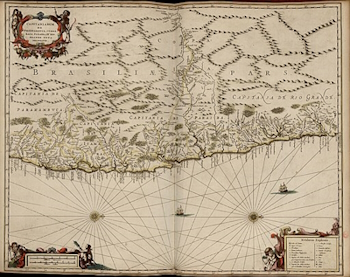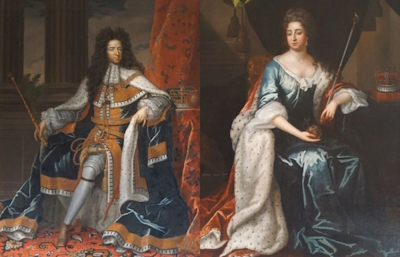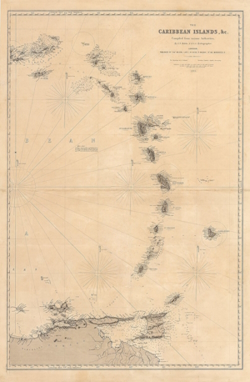 Although a Bourbon king, Philip V, took the throne of Spain after the War of Spanish Succession came to an end, Spain had been forced to give up territory in Italy and the Spanish Netherlands under the 1713 Peace of Utrecht. In 1718, the Spanish wanted to recover some of that lost land. As a result, the conflict known as the War of the Quadruple Alliance broke out between Spain and a coalition consisting of Great Britain, France, and Savoy, later joined by Austria after they had signed peace with the Ottomans. The Dutch Republic also joined the coalition in 1719. The war took place mainly in Sicily and northern Spain with some minor engagements in North America. Additionally, the Spanish supported Jacobite rising of 1719 in Scotland, which is considered to be a part of this conflict.
Although a Bourbon king, Philip V, took the throne of Spain after the War of Spanish Succession came to an end, Spain had been forced to give up territory in Italy and the Spanish Netherlands under the 1713 Peace of Utrecht. In 1718, the Spanish wanted to recover some of that lost land. As a result, the conflict known as the War of the Quadruple Alliance broke out between Spain and a coalition consisting of Great Britain, France, and Savoy, later joined by Austria after they had signed peace with the Ottomans. The Dutch Republic also joined the coalition in 1719. The war took place mainly in Sicily and northern Spain with some minor engagements in North America. Additionally, the Spanish supported Jacobite rising of 1719 in Scotland, which is considered to be a part of this conflict.
Tag: Wars and revolts
Palmares
 In the early 17th century an autonomous, self-sufficient community of escaped slaves (maroons) known as Palmares established itself in the Captaincy of Pernambuco in north-eastern Brazil. It grew considerably throughout the 17th century, eventually becoming the largest settlement ever founded by runaway slaves in Brazil. Most of the information about this community comes from Portuguese and Dutch colonists and many of the names of those involved are unknown. At its apex, the population of Palmares reached somewhere between 10,000 and 20,000. The Palmaristas constantly resisted Portuguese and Dutch attacks while at the same time carrying out their own raids on the colonists. In the 1500s nearly half of all those enslaved from Africa were transported to Brazil, which was governed by the Portuguese at the time. Their settlements, called mocambos or quilombos, were constructed in the land’s interior, although the later is a modern term. At its height in the 1660s, Quilombo of Palmares was a confederation with a central capital and associated fortified towns and villages.…
In the early 17th century an autonomous, self-sufficient community of escaped slaves (maroons) known as Palmares established itself in the Captaincy of Pernambuco in north-eastern Brazil. It grew considerably throughout the 17th century, eventually becoming the largest settlement ever founded by runaway slaves in Brazil. Most of the information about this community comes from Portuguese and Dutch colonists and many of the names of those involved are unknown. At its apex, the population of Palmares reached somewhere between 10,000 and 20,000. The Palmaristas constantly resisted Portuguese and Dutch attacks while at the same time carrying out their own raids on the colonists. In the 1500s nearly half of all those enslaved from Africa were transported to Brazil, which was governed by the Portuguese at the time. Their settlements, called mocambos or quilombos, were constructed in the land’s interior, although the later is a modern term. At its height in the 1660s, Quilombo of Palmares was a confederation with a central capital and associated fortified towns and villages.…
The Glorious Revolution of 1688
 The ‘Glorious Revolution’, or de Glorieuze Overtocht in Dutch, is often called the Bloodless Revolution as there was very little bloodshed in England itself, although in Ireland it was a particularly bloody affair. Most ordinary people weren’t directly affected by the invasion as they had been during the Civil Wars (1642-52). In his book The King Over the Water, Desmond Steward said of it: “The events of 1688 were not so much a revolution as an aristocratic coup d’etat that ended in a one party state …” The events of 1688 were probably more significant politically for England than the Civil Wars as there were very few real changes to the system after the latter. Although William was invited to take the throne by some notable English figures, his arrival on British shores is still viewed by many as an invasion of England by the Dutch to remove a potential ally of Louis XIV of France.…
The ‘Glorious Revolution’, or de Glorieuze Overtocht in Dutch, is often called the Bloodless Revolution as there was very little bloodshed in England itself, although in Ireland it was a particularly bloody affair. Most ordinary people weren’t directly affected by the invasion as they had been during the Civil Wars (1642-52). In his book The King Over the Water, Desmond Steward said of it: “The events of 1688 were not so much a revolution as an aristocratic coup d’etat that ended in a one party state …” The events of 1688 were probably more significant politically for England than the Civil Wars as there were very few real changes to the system after the latter. Although William was invited to take the throne by some notable English figures, his arrival on British shores is still viewed by many as an invasion of England by the Dutch to remove a potential ally of Louis XIV of France.…
King William’s War
 The name King William’s War was given to the American theatre of operations in the Nine Years’ War. It was probably named so because the war broke out when William III ascended to the throne of England and because of the financial interests he held in the Hudson Bay Company. It was fought on a much smaller scale than in Europe. One area of contention was the fur trade in the colonies, another was Caribbean trade. England and Spain, who were traditionally enemies in the Caribbean, were now allied against France, but although the Allies had for the most part the naval advantage in this region, it proved impossible to keep the French from supplying their colonial forces.
The name King William’s War was given to the American theatre of operations in the Nine Years’ War. It was probably named so because the war broke out when William III ascended to the throne of England and because of the financial interests he held in the Hudson Bay Company. It was fought on a much smaller scale than in Europe. One area of contention was the fur trade in the colonies, another was Caribbean trade. England and Spain, who were traditionally enemies in the Caribbean, were now allied against France, but although the Allies had for the most part the naval advantage in this region, it proved impossible to keep the French from supplying their colonial forces.
Nine Years’ War
 The Nine Years’ War, which took place from 1688-1697, was also known as the war of the Grand Alliance, or King William’s War in the Americas. The Grand Alliance was formed by England, the Dutch Republic, and the Grand Duchy of Austria, later to be joined by others, including Spain and Savoy, to oppose Louis XIV’s expansionism on the Rhine and in northern Italy. Louis XIV’s anti-protestant policies, in particular the persecution of the French Huguenots, also made him unpopular with protestant rulers in Europe. This war also sometimes mistakenly referred to as the War of the League of Augsburg after the coalition formed in 1686 by Emperor Leopold I, the kings of Sweden and Spain, and the electors of Bavaria, Saxony, and the Palatinate against the increasing French threat. Louis XIV also made himself unpopular in England by lending his support to the Jacobite cause of the deposed James II of England, attempting to instigate a Catholic crusade to restore James to the throne.…
The Nine Years’ War, which took place from 1688-1697, was also known as the war of the Grand Alliance, or King William’s War in the Americas. The Grand Alliance was formed by England, the Dutch Republic, and the Grand Duchy of Austria, later to be joined by others, including Spain and Savoy, to oppose Louis XIV’s expansionism on the Rhine and in northern Italy. Louis XIV’s anti-protestant policies, in particular the persecution of the French Huguenots, also made him unpopular with protestant rulers in Europe. This war also sometimes mistakenly referred to as the War of the League of Augsburg after the coalition formed in 1686 by Emperor Leopold I, the kings of Sweden and Spain, and the electors of Bavaria, Saxony, and the Palatinate against the increasing French threat. Louis XIV also made himself unpopular in England by lending his support to the Jacobite cause of the deposed James II of England, attempting to instigate a Catholic crusade to restore James to the throne.…
